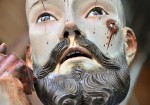 Restorers from Mexico’s National Institute of Anthropology and History (INAH) working on a polychrome statue of the Christ of Patience have found eight human teeth in the figure’s mouth. These types of statues often have teeth, but they’re carved out of wood or bone either as a plate or as individual teeth. This is the first time actual human teeth have been found.
Restorers from Mexico’s National Institute of Anthropology and History (INAH) working on a polychrome statue of the Christ of Patience have found eight human teeth in the figure’s mouth. These types of statues often have teeth, but they’re carved out of wood or bone either as a plate or as individual teeth. This is the first time actual human teeth have been found.
 The ends of the teeth can be seen through the open mouth of the statue (they’re rather impressively white and even, too), but it wasn’t until restorers X-rayed the head to determine its conservation needs that they saw that they were full adult teeth complete with roots. According to Fanny Unikel, head restorer of INAH’s Restoration Workshop of Polychrome Sculpture of the National School of Conservation, Restoration and Museology (ENCRyM), the teeth were probably donations made by devout parishioners, a practice seen frequently with far less painful materials like hair for wigs or clothing. Had they been saintly relics, they would have been displayed on their own and highlighted for people to revere.
The ends of the teeth can be seen through the open mouth of the statue (they’re rather impressively white and even, too), but it wasn’t until restorers X-rayed the head to determine its conservation needs that they saw that they were full adult teeth complete with roots. According to Fanny Unikel, head restorer of INAH’s Restoration Workshop of Polychrome Sculpture of the National School of Conservation, Restoration and Museology (ENCRyM), the teeth were probably donations made by devout parishioners, a practice seen frequently with far less painful materials like hair for wigs or clothing. Had they been saintly relics, they would have been displayed on their own and highlighted for people to revere.
The dental implant Christ is one of a group of 17th and 18th century statues of the saints belonging to the church of San Bartolo Cuautlalpan, a farming community in the central Mexico municipality of Zumpango. They have major condition problems — missing parts, termite and rodent damage, multiple layers of overpainting obscuring the original paint, bad previous repair attempts, thick coatings of hardened eggs and baby oil used by the parishioners to polish the statues — and have undergone an extensive program of restoration this year.
 Saint Bartholomew, Saint Joachim, Saint Anne and Our Lady of Sorrows were all in significantly worse condition than the Christ of Patience. He may be drenched in blood and have bone-deep gouges in the flesh of his cheek and knee, but over the centuries he was always covered in clothing and only taken out for the Holy Week procession. The other statues have carved clothes and appear on saint days and other religious events; some spent time in a warehouse where they were at the mercy of vermin and less than ideal climactic conditions. Our Lady of Sorrows has a very rare mechanical element — her hands could be raised to her face as if she were crying — that hasn’t worked in years. In order to examine her insides with the aim of repairing the mechanism, restorers had to give her a CT scan because X-rays couldn’t see through the layer of lead paint, one of eight layers of overpainting just on this one statue.
Saint Bartholomew, Saint Joachim, Saint Anne and Our Lady of Sorrows were all in significantly worse condition than the Christ of Patience. He may be drenched in blood and have bone-deep gouges in the flesh of his cheek and knee, but over the centuries he was always covered in clothing and only taken out for the Holy Week procession. The other statues have carved clothes and appear on saint days and other religious events; some spent time in a warehouse where they were at the mercy of vermin and less than ideal climactic conditions. Our Lady of Sorrows has a very rare mechanical element — her hands could be raised to her face as if she were crying — that hasn’t worked in years. In order to examine her insides with the aim of repairing the mechanism, restorers had to give her a CT scan because X-rays couldn’t see through the layer of lead paint, one of eight layers of overpainting just on this one statue.
 Compared to his mother’s travails, Jesus has had it relatively easy. After examining the statue closely and X-raying to determine any internal damage, restorers found his structure is sound. The statue was cleaned and some areas of paint loss on the torso, sandal, legs and soles of the feet were filled in using a technique called rigatino which lays stripes of several hues in short brush strokes that from a distance blend in with the original painting but that do not attempt to disguise the fact that restoration was done. The platform on which Christ of Patience sits had been overpainted in a tragic beige. Restorers were able to remove it and reveal the reds and greens of the original polychrome.
Compared to his mother’s travails, Jesus has had it relatively easy. After examining the statue closely and X-raying to determine any internal damage, restorers found his structure is sound. The statue was cleaned and some areas of paint loss on the torso, sandal, legs and soles of the feet were filled in using a technique called rigatino which lays stripes of several hues in short brush strokes that from a distance blend in with the original painting but that do not attempt to disguise the fact that restoration was done. The platform on which Christ of Patience sits had been overpainted in a tragic beige. Restorers were able to remove it and reveal the reds and greens of the original polychrome.
There are some lovely gruesome views of the statue in this Spanish-language video featuring restorer Fanny Unikel talking about the teeth, the statue’s excellent condition and restoration.
[youtube=http://youtu.be/Z-OqM89EagY&w=430]